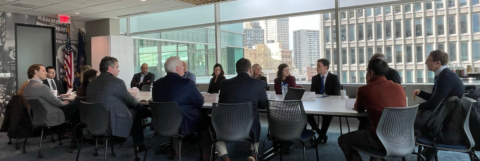Key Takeaways:
- The federal government has a role in Michigan’s mobility workforce transition as a convening power.
- Many successful pilot programs in the Detroit Region lack the funding to scale to demand.
On Feb. 7, MICHauto hosted representatives from the White House’s National Economic Council (NEC) as well as stakeholders across Michigan’s government, education, and industry for a roundtable on the future of the mobility workforce in Detroit. As a federal entity, the NEC is seeking a better understanding of how they can support the supply chain with their three-pronged approach, which includes:
- Giving manufacturers more certainty around the industry transition.
- Opening access to capital for small manufacturers to diversify product lines with new and existing infrastructure.
- Determining workforce demands and ensuring existing workers are put at the forefront.
National Standard Needed for Battery Cell Manufacturing Training
Deeana Ahmed, Chief Strategy Officer of Our Next Energy (ONE), opened the conversation by proposing a national standard for training the battery manufacturing workforce. This work has already begun in companies like LG Energy Solution, Stellantis, and Ford, who were also represented at the table.
“We have a legacy of battery manufacturers from Michigan and have experience in training our workforce, but we don’t have national standards in cell manufacturing yet,” she said. “[Without it,] we’re not preparing folks to have access to the industry broadly.”
When asked what prevents companies from creating a standard, Ahmed shared that efforts are underway but are not happening as forcefully or cohesively as required. A top-down approach would be a valuable motivator.
Drew Coleman, MICHauto’s Senior Director, asked whether the industry should create guidelines for the federal government to adopt or vice versa. He also echoed Ahmed’s point that the Detroit Region certainly has the density of partners to create this national cohesion around standards, and the state is off to a good start in supporting this work with initiatives like the EV Jobs Academy and the Going PRO Talent Fund, which supports on-the-job training.
However, there is currently only enough money to fund half of the applications received. With federal dollars, this program could double its impact. However, federal money can’t always be used for upskilling, which does not offer impressive numbers in job creation.
As a testament to this, Bill Kregel, BorgWarner’s Vice President of Government Affairs, shared that their manufacturing facility in Cadillac has always produced traditional ICE thermal products but is transitioning to making e-heaters for trucks beginning this fall and seeking domestic conversion grants to support.
Workforce Has Mixed Feelings About the Industry’s Transition
With many changes in workforce expectations and new opportunities, existing workers have expressed mixed feelings about the transition. While some are intrigued by the potential for higher pay, others are resistant to making such a large change at the end of their careers, which would require hourly workers to take a break from work and go back to the classroom. There is also a discrepancy in the availability of cohesive training depending on location, with many companies based in rural areas of Michigan.
Additional barriers to enhancing workforce training are the lack of state-of-the-art equipment at community colleges, lack of funding for pre-employment training programs, the distance between the workforce and their job site, and high school diploma requirements in job postings, according to Spencer Lucker from the Michigan Economic Development Corporation, Ron Stallworth from Stellantis, and Ann Thompson from Ford.
Strengthening the Talent Pipeline to Fill Workforce Gaps
Regarding reinforcing the talent pipeline, the Detroit Regional Chamber is paving the way. The Chamber’s Education and Talent Team, made up of departments focused on Employer Engagement, Collective Impact, and the Detroit Promise, has increased local educational completion rates by partnering with the Detroit Area Talent Fund to provide rapid response emergency grants to students pursuing STEM majors and through a partnership being finalized with the United Way, which offers wraparound services. With access to a diverse future workforce, the Chamber seeks a mechanism to regularly connect them with employers.
In addition to creating equitable pathways for students to enter the workforce, the industry is connecting with formerly incarcerated individuals and immigrants, breaking through cultural barriers and the lack of trust to connect them to the industry’s available opportunities. Taylor pointed out that the responsibility of carrying out decisions made in board rooms to support these workers is often put on frontline supervisors, who need to buy into these decisions and be adequately compensated.
Overall, the federal government can support the future of the mobility workforce in Detroit by getting capital out the door faster, helping small companies find impact projects that will maintain their relevance within a changing supply chain, and filling coordination gaps. Jonathan Smith from the Department of Labor and Economic Opportunity closed by saying, “If we start preparing now, we can create economic opportunity for everyone in this state.”
Thank you to the following organizations for their participation in this critical discussion:
- BorgWarner
- Burning Glass Institute
- Detroit Regional Chamber
- Ford Motor Company
- Department of Labor and Economic Opportunity
- LG Energy Solution
- Macomb Community College
- MICHauto
- Michigan Economic Development Corporation
- Michigan Workforce Training & Education Collaborative
- National Economic Council
- Our Next Energy
- Stellantis
- University of Michigan

